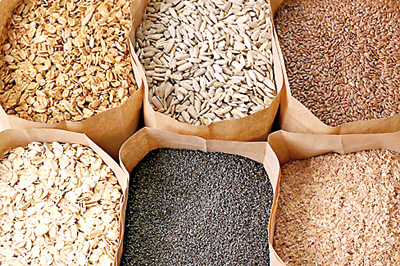As we continue with our series, this month Nutrition Specialist
1:Your body needs cholesterol to function: Cholesterol is essential for us. It is an essential part of all cell walls, insulates nerves, is a component of some hormones, and helps in production of vitamin D, which is critical for healthy bones and other functions of the body. It stops being good when its presence in the blood exceeds normal levels. Our bodies make and use a certain amount of cholesterol every day, but sometimes that system gets out of control, either through genetic tendency or a poor diet and lack of exercise. High cholesterol or hypercholesterolemia is a condition wherein the level of fat and cholesterol in your body is too high. Dyslipidemia is when any of the lipid levels are abnormal (either high or low) e.g. high LDL or low HDL.

Manage your cholesterol better with more whole grains and fruits (top right) in your diet
2: The main cause of high cholesterol is genetic: High cholesterol can run in families. The rest is determined by what kind of lifestyle you lead. Dietary intake of high amounts of saturated fats, high amounts of starchy foods or trans-fats (a type of fat formed when oil goes through a process called hydrogenation, which makes the oil more solid, and also present in small amounts in animal foods) and lack of physical activity can lead to changes in cholesterol levels.
3: The biggest source of cholesterol isn’t your diet: The largest source of cholesterol in our body is synthesis in the body. A wax like substance, cholesterol is found in every cell in our body. While it is manufactured in the body, it is also taken from food sources. Since cholesterol is not water soluble, it is transported around in our blood to and from cells by two types of products known as lipoproteins, which act as carriers. These are low-density lipoprotein, or LDL, and high-density lipoprotein, or HDL. LDL cholesterol and HDL cholesterol, along with triglycerides, make up most of the total cholesterol in our blood.
4: When it forms plaque, it can lead to a stroke/heart attack: Cholesterol and fats flowing through the blood can stick to the inside of artery walls and form a thick, hard deposit called “plaque.” Plaque forms especially when cholesterol levels are high and it causes an artery to narrow, so less blood can go through, causing complete or almost complete blockage of arteries leading to a heart attack or stroke. Plaque can also break open and cause blood clots. that block blood vessels in the heart or brain.
LDL cholesterol is considered the “bad” cholesterol because it contributes to plaque. Therefore, high levels of LDL increases risk of heart disease.
HDL cholesterol is considered “good” cholesterol because it helps remove LDL cholesterol from the arteries and back to the liver, where it is broken down and passed from the body. A healthy level of HDL cholesterol may also protect against heart attack and stroke. Low levels of HDL cholesterol may increase the risk of heart disease.
Triglycerides are another type of fat, and they store excess energy from the diet. High triglycerides can contribute to a high total cholesterol level, including a high LDL cholesterol (bad) level and a low HDL cholesterol (good) level and therefore, plaque formation.
5: Often, someone with high cholesterol exhibits no symptoms: Oftentimes, there are no symptoms of hypercholesterolemia, which is the disease of high cholesterol. That is why it is important for everyone to be tested. A simple blood test can measure cholesterol (make sure to fast 12 hours before you have your blood taken for the test). Anyone over the age of 20 should have their cholesterol checked. And, older persons, should have their cholesterol checked regularly.
6: Cholesterol cannot be reduced in a hurry: One has to work at improving the lifestyle through diet and exercise. If levels are very high, drugs may be needed. But, even if one is taking drugs for high cholesterol, they still have to pay attention to their diet and to exercising enough.
A healthy diet low in saturated fats and unrefined carbohydrates is important. To manage your cholesterol better, eat more whole grains, fruits, vegetables, animal and plant proteins such as soy. No vegetable product will contain cholesterol. However, foods high in saturated fat include meat, dairy products, some oils such as palm or coconut oil and processed foods made with cocoa butter, palm oil, or coconut oil e.g. biscuits, pastries, can eventually raise blood cholesterol levels. Eating too many calories, in general, can elevate triglycerides. Further, the amount of alcohol that is taken should be reduced, if consumption is high.
7: Lifestyle changes are essential to managing cholesterol: Diet alone is not enough. It has to be a lifestyle change. Being overweight /obese increases the risk of having high cholesterol. People with a high body mass index (BMI) tend to have lower levels of “good” HDL and higher levels of “bad” LDL cholesterol and triglycerides than people of normal weight.Cigarette smoking damages arterial walls, making them more susceptible to plaque buildup. It may also lower HDL cholesterol.High triglycerides can be caused by being overweight or obese, physically inactive, cigarette smoking, excess alcohol and a high starch diet. Many people with heart disease or diabetes also have high triglycerides.
Being sedentary can contribute to high blood cholesterol levels. Regular exercise – 30 minutes of moderate intensity activity most days of the week helps. Exercise stimulates enzymes that help move LDL from the blood (and blood-vessel walls) to the liver. Reduced time spent sitting around (TV watching etc) can help lower “bad” LDL cholesterol.


